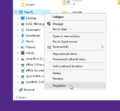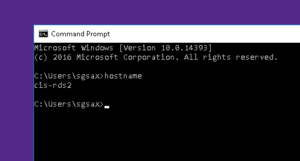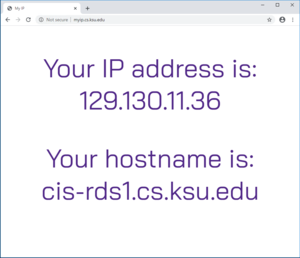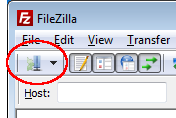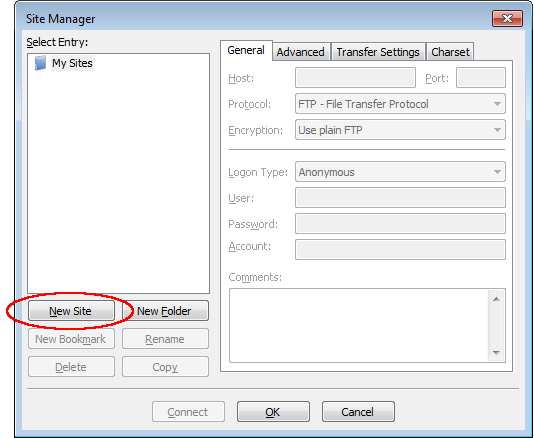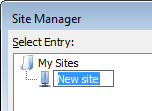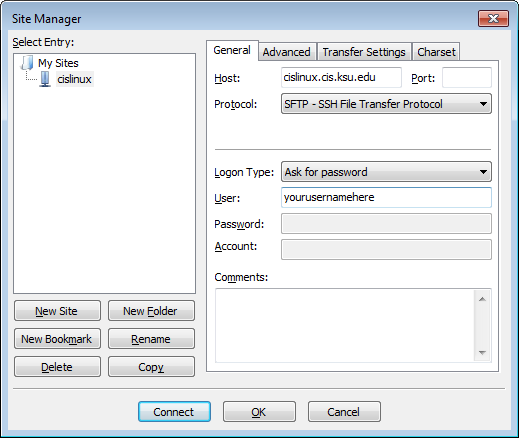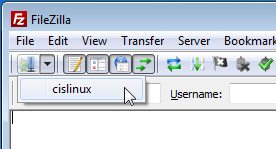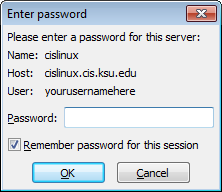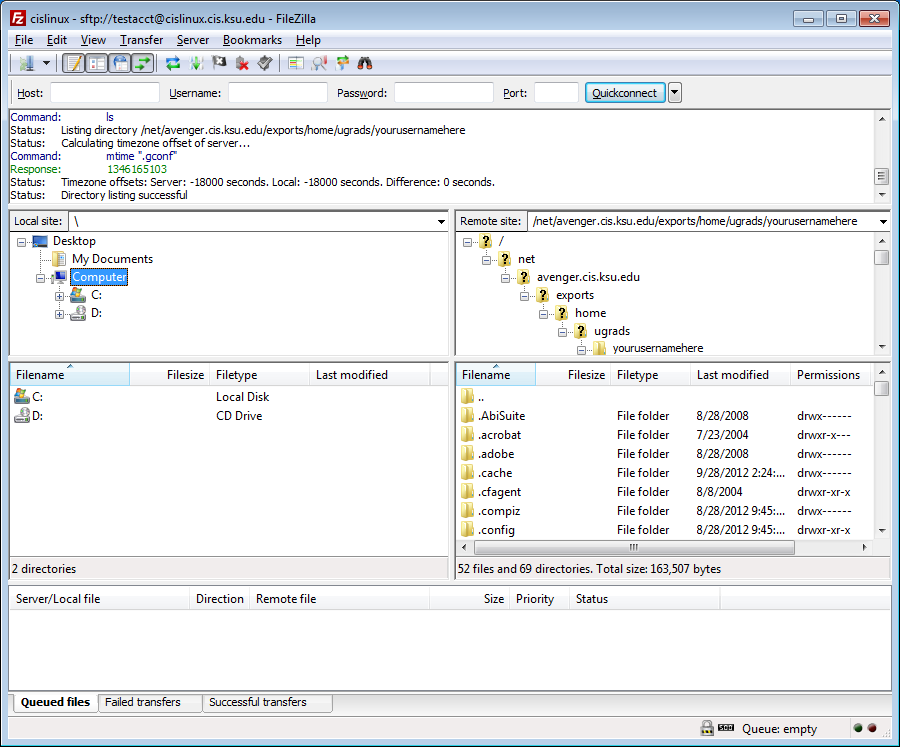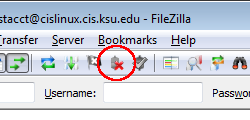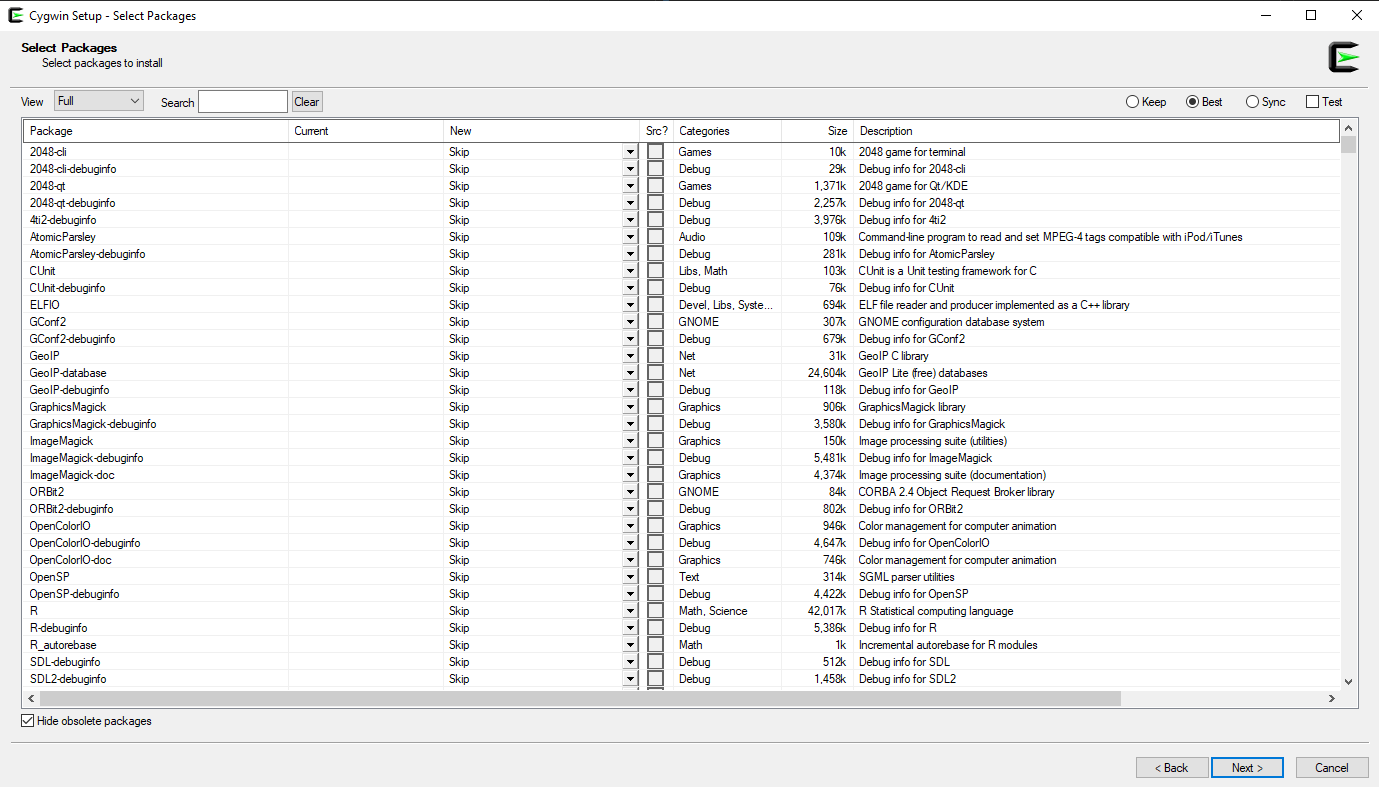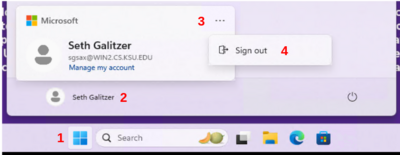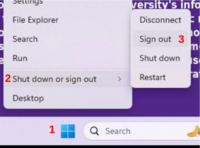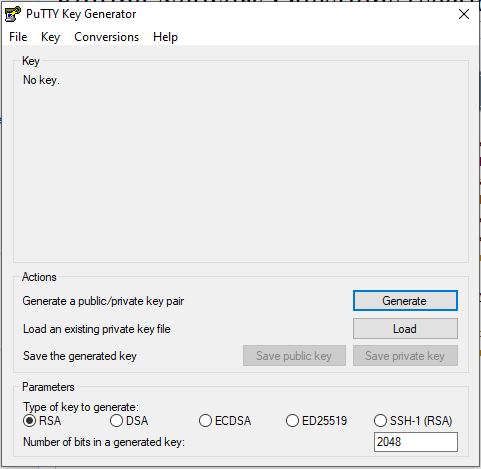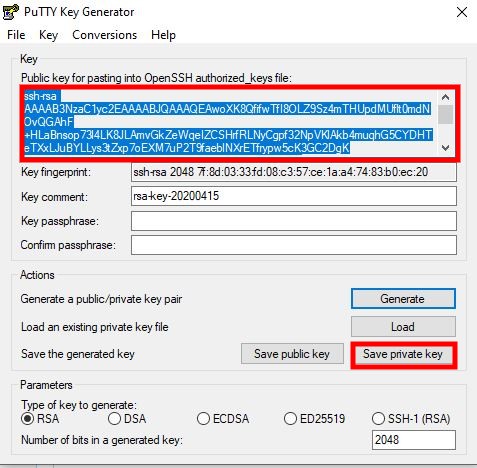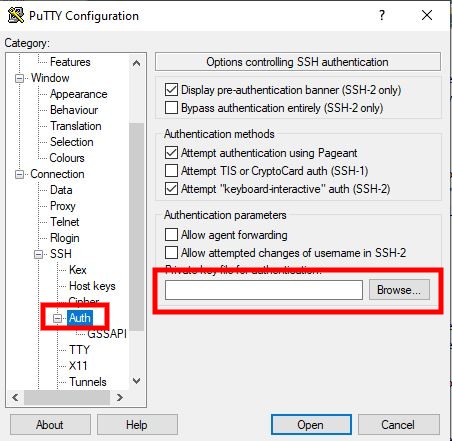Difference between revisions of "FAQ"
(edited headpings) |
|||
| (7 intermediate revisions by 2 users not shown) | |||
| Line 1: | Line 1: | ||
= Windows Questions = | = Windows Questions = | ||
| − | {{:Windows_Questions}} | + | {{:Windows_Questions }} |
= Linux Questions = | = Linux Questions = | ||
| − | {{:Linux_Questions}} | + | {{:Linux_Questions }} |
= Network Questions = | = Network Questions = | ||
| − | {{:Network_Questions}} | + | {{:Network_Questions }} |
| − | = | + | = IRC = |
| + | {{:IRC }} | ||
| + | = Miscellaneous Questions = | ||
{{:Misc_Questions}} | {{:Misc_Questions}} | ||
Latest revision as of 17:39, 27 January 2015
Windows Questions
I need some software by Microsoft for a project, can you give it to me?
Possibly. All CS students have access to a variety of Microsoft software through the Azure Portal.
Logging in to the Azure Portal
- First, you need to go Microsoft Azure Dev Tools for Teaching and simply click on
 .
.
- Next, you will be prompted to sign in to your Microsoft account. You must use your K-State email address to sign in properly.

- If you get a screen like the one below, be sure to click on the top option labeled "Work or school account created by your IT department"
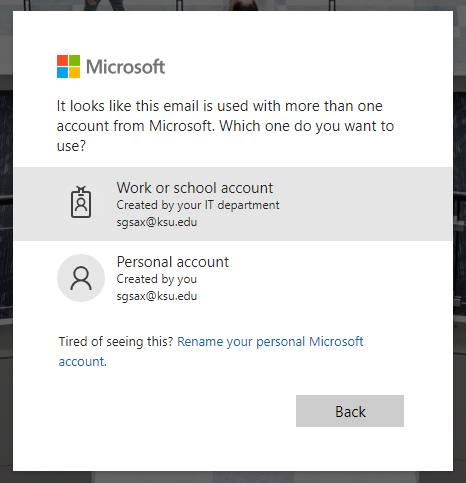
- You should now be redirected to the K-State sign in page. Simply log in normally using your eID and K-State password.
- If you have signed in properly you will be greeted by a page looking like the one below.
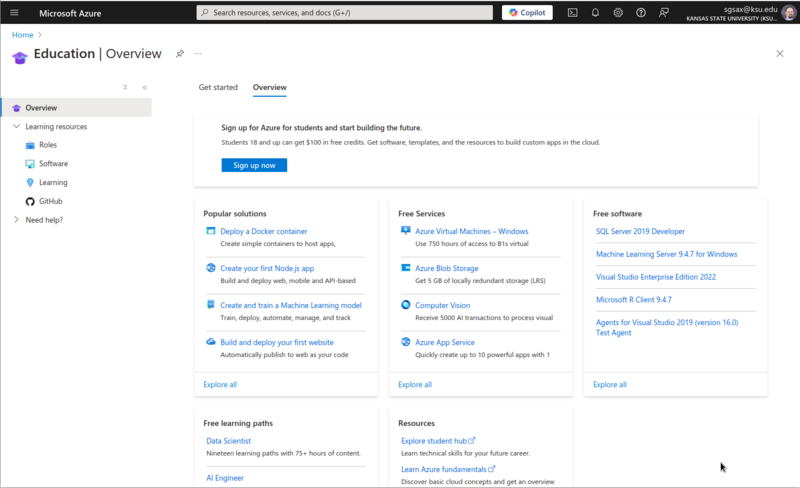
Downloading and Registering Software
- To use the software you need to first download it. Click on Software under Learning resources in the left menu, or Explore all in the Free software block in the main page.
- You will now be directed to a search page, where you can enter a full or partial product name. Visual Studio is used in this example, but the same applies to all software that requires local installation.
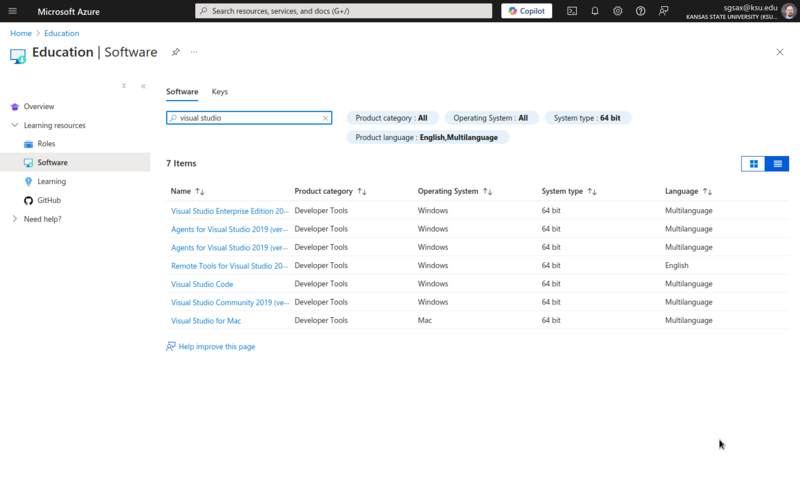
- Click on the product you want and a new frame will open on the right side of the page.
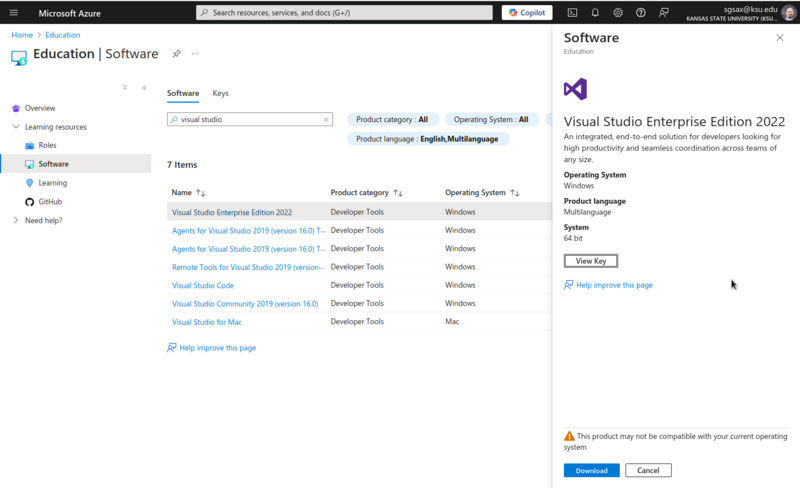
- To download Visual Studio, click on Download and follow the instructions. Once you have downloaded and installed Visual Studio, you need to register it. You should always register all the software you are planning on using for a prolonged period of time, such as for a full semester.
- To register Visual Studio, click on View Key and copy the license key provided. You will need to use that license key to register Visual Studio on your account.
License Agreement
Remember, this is for your own personal use as a CS student. You are not legally permitted to download software for your friends or families. Doing so will break the terms of the Microsoft academic agreement. Distributing illegal copies of software is against state and federal laws and the policies of this university.
How do I tell what server I am on when connected to remote.cs.ksu.edu?
GUI method
- Click Start -> Windows System -> File Explorer
- Right-click on This PC and select Properties. The computer name is shown in this window as indicated in the screenshot.
CLI method
- Open a Command Prompt or Powershell window
- Type
hostnameat the prompt. The computer name is returned in the window as shown in the screenshot.
Web method
Open any web browser to the URL http://myip.cs.ksu.edu/. The computer IP and hostname will be displayed on the page.
Note: This only works from hosts within the department, including the RDS servers.
How do I take a screenshot in Windows?
To take a screenshot (image of the screen) in Windows, follow the following steps:
- Press "Print Scrn" on the keyboard (next to "Scroll Lock" at the top).
- Open Microsoft Paint (Start Menu > All Programs > Accessories > Paint).
- Go to Edit > Paste to paste the image.
- Save the image as a BMP in your home directory by going to File > Save As...
- Do with the image as you please.
How do I enable X forwarding in Windows?
The following explains the process of enabling X forwarding through SSH to view X applications in Windows.
- Start XServer by going to Start > XServer
- Open PuTTY by going to Start > PuTTY
- In the Category menu for PuTTY, select Tunnels
- Check the box next to "Enable X11 Forwarding"
- In the Category menu for PuTTY, select Session
- Under Host Name, type "cslinux.cs.ksu.edu"
- Choose SSH as your Protocol
- Now click "Open"
- Enter your username and password when prompted
- Enjoy
You can test to see if X forwarding is working by typing "xeyes", which should bring up an application with two eyes following your mouse pointer.
How do I transfer files to or from the CS systems?
NOTE: Due to authentication problems and account lockouts caused by WinSCP, we no longer recommend using this application for file transfer. We suggest the following instead.
FileZilla is a good cross-platform desktop file transfer application that is both free to use and open source. You can download the client from https://filezilla-project.org/download.php?show_all=1 and install it on your own system.
NOTE: Do NOT download FileZilla from the filezilla-project home page. The software is bundled with sponsored programs that can be malicious. Use the link provided above.
When you launch FileZilla, the window looks like this:
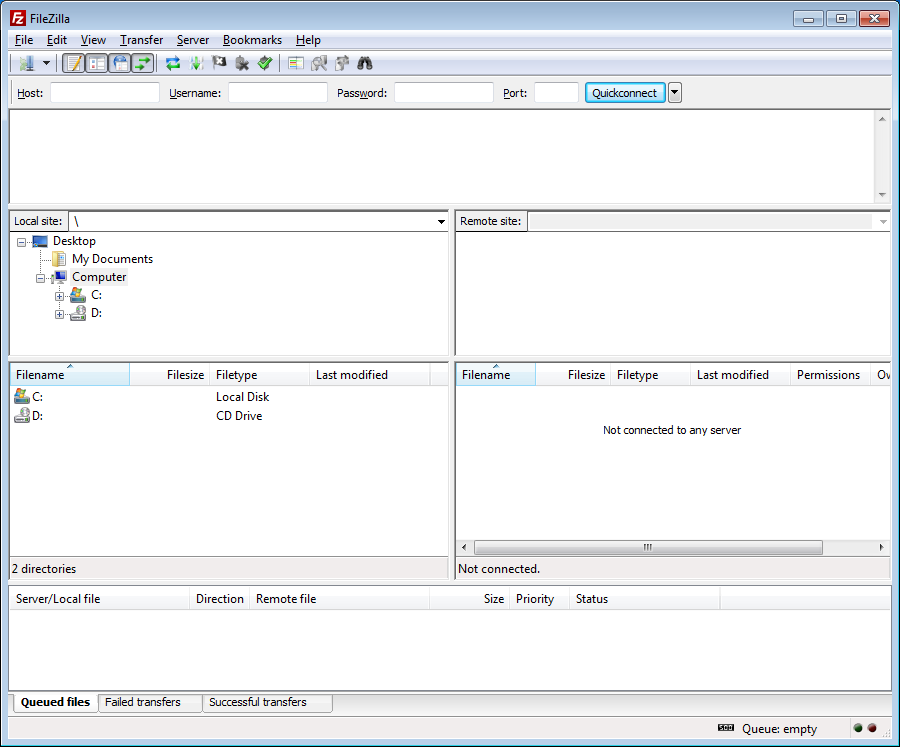
First-time users will need to create a new connection which you can re-use later.
- Click on the the Site Manager button here:
- This opens up a new window. Click on the "New Site" button.
- Set the name of your new site to something easy to remember, like the name of the server you are connecting to.
- Make the following changes to the site settings:
- Protocol: SFTP - SSH File Transfer Protocol
- Login Type: Ask for password
- User: enter your username here, not your full email address
- You should now be returned to the main window. Click on the dropdown next to the Site Manager button and select your newly saved site.
- You will be prompted for your password. Enter it here. NOTE: This is your CS password, not your KSU eID password.
- Once connected, the main window should look like this. Transfer files by selecting the source on the left and destination on the right.
- When you are finished, click on the Disconnect button.
How do I burn an .ISO image to a Disc?
N022 and N126 labs have DeepBurner installed on the Windows machines along with CD/DVD burners. This is free software and is available to download for your own personal use at http://www.deepburner.com/.
To burn an .iso to CD/DVD, place a blank disc in the CD/DVD ROM tray and run DeepBurner. When the program starts, it will prompt you to select the project type. Select "Burn ISO image." Click the "..." button beside the Image file text box to specify the location of your saved .iso file. Click the "Burn ISO" button to begin burning the disc.
Clearing My Windows RDP Certificate Cache
If for some reason you find that the certificate's your windows machine has cached are invalid you may need to clear that cache and here are the steps to do that. Warning to do this involves editing your PC's registry. If you deviate from the steps laid out in this article there is a chance you could do serious harm to your computer, so be careful.
- Press the windows key+r and type
regeditin the box that apears. - On the left side of the screen you will see a series of keys denoted by the folder icon. Select the drop down icon for the following keys.
\HKEY_CURRENT_USER\Software\Microsoft\Terminal Server Clientand select the folder (not the drop down icon) labeled Default. - There should be an series of entries labeled "MRUX" where is X is a different number for each entry and they should have names of servers you have connected to to their right. Select all the servers you would like to remove right click and delete them.
- There will also be a key labeled Servers if you click it's drop down it may have sub-keys labeled with the name of the server it holds information for. If the server you wish to remove has a sub right click and delete the entire key, it will prompt you with a warning about removing information click okay.
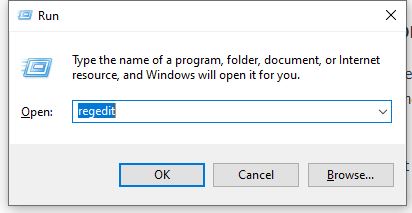
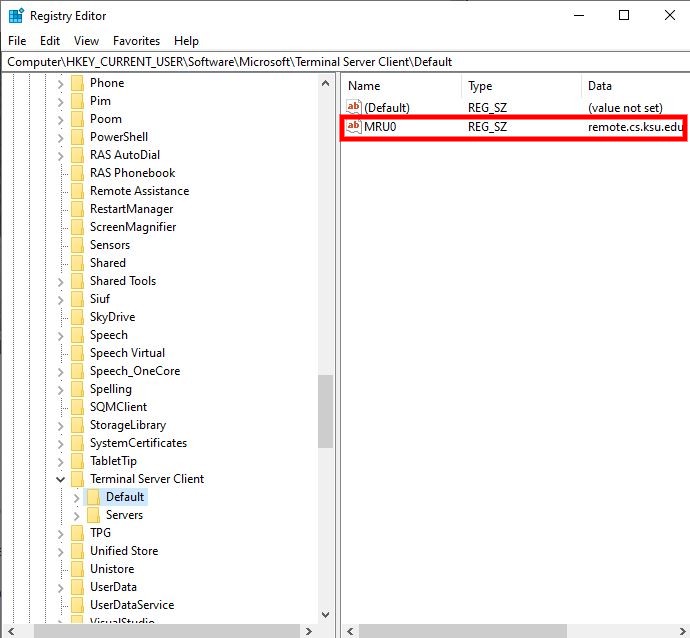
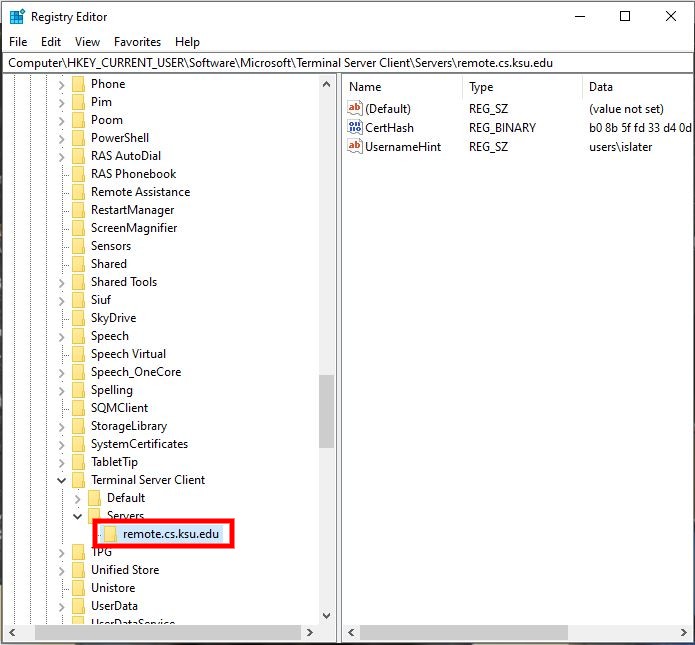
Cygwin
Introduction
If you are using windows it is likely at some point you have need some GNU tools at some point. Cygwin is a collection of common gnu utilities compiled to run on windows.
Instillation
First download the installer from cygwin's website https://cygwin.com/install.html select setup-x86_64.exe and download the installer. On the first screen select "install from the internet". Then you can leave the defaults for the rest of the windows until you are asked which server you would like to install from. Select the first server listed which should be http://cygwin.mirror.constant.com. Next you will be prompted with this screen showing all the possible packages you can install.
You can select which package you want by double clicking the word skip or clicking the drop down menu and selecting the most recent version. When you are done selecting packages click next then finish. Cygwin will download and install your packages this may take a while.
Clion
In addition to installing the CLion IDE you will need to install a C compiler, the build tool make, and a C debugger. These do not come bundled with CLion because CLion likes to give you the option of where you get these from. We support using Cygwin to install these packages. Follow the steps as listed above and make sure to install the following.
- gcc-g++
- clang
- make
- gdb
There will be a lot of packages with names similar to these but be sure to install these. Then open Clion and click file then settings and search for toolchain. Click the + button and select Cygwin from the drop down. Clion should automatically find the proper .exe files for you. If it can not you will need to choose the following.
- Make
c:\cygwin\bin\make.exe - C Compiler
c:\cygwin\bin\gcc.exe - C++ Compiler
c:\cygwin\bin\c++.exe - Debugger
c:\cygwin\bin\gdb.exe
Then with Cygwin selected in the sidebar press the up arrow next to the plus sign until Cygwin is at the top, it should now say "(default)" next to it. Now close out and reopen Clion and you Cygwin should be your default toolchain.
How do I log out of Windows 11 on Lab Computers?
Are you confused about this? So are we. Normally, to logout of a Windows desktop, you would click on the user account icon on the Start Menu and then click Sign Out. On some desktops, this direct method no longer works. Here are two non-obvious ways to sign out of Windows 11.
Method 1
- Click on the Start Menu icon
- Click on your user name
- click on the three dots in the upper right hand corner of the flyout
- Click on Sign out
Method 2
- Right-click on the Start Menu icon
- Click on Shut down or sign out
- Click on Sign out
It's just that easy.
Linux Questions
NOTE: Parts of this document are borrowed heavily from the excellent documentation found in the Beocat wiki. Please have a look there for more details and in-depth examples.
How do I connect to Linux systems?
To login remotely to CS Linux systems, you first need an "SSH Client". SSH, short for "secure shell", is a protocol that allows secure communication between two computers. We recommend the following.
- Windows
- PuTTY is by far the most common SSH client, both for CS and in the world.
- MobaXterm is a fairly new client with some nice features, such as being able to SCP/SFTP (see below), and running X (Linux graphical desktop).
- Cygwin is for those that would rather be running Linux but are stuck on Windows. It's purely a text interface.
- Macintosh
- OS-X has SSH a built-in application called "Terminal". It's not great, but it will work for most CS users.
- iTerm2 is the terminal application we prefer.
- Others
- There are many SSH clients for many different platforms available. While we don't have experience with many of these, any should be sufficient for access to CS Linux systems.
You'll need to connect your client (via the SSH protocol, if your client allows multiple protocols) to cslinux.cs.ksu.edu.
For command-line tools, the command to connect is
ssh username@cslinux.cs.ksu.edu
Your username is your CS login (usually the same as your K-State eID) and the password is your CS password (which is only the same as your eID password if you set it manually or using our password reset page).
Note: When you type your password, nothing shows up on the screen, not even asterisks.
The first time you log into a new host, you will be asked to confirm adding the SSL signature to your local repository. Just say "yes" in whatever appropriate form when asked.
You'll know you are successfully logged in when you see a prompt that says
username@hostname:~$
where hostname is the name of the machine you've logged into (currently either 'cougar' or 'viper') and username is your eID username
How do I transfer files to/from Linux systems?
Usually, one of the first things people want to do is to transfer files into or out of their CS account. To do so, you need to use SCP (secure copy) or SFTP (SSH FTP or Secure FTP). Again, there are multiple programs that do this.
- Windows
- Putty (see above) has PSCP and PSFTP programs (both are included if you run the installer). It is a command-line interface (CLI) rather than a graphical user interface (GUI).
- MobaXterm (see above) has a built-in GUI SFTP client that automatically changes the directories as you change them in your SSH session.
- FileZilla (client) has an easy-to-use GUI. Be sure to use 'SFTP' mode rather than 'FTP' mode.
- WinSCP is another easy-to-use GUI.
- Cygwin (see above) has CLI scp and sftp programs.
- Macintosh
- FileZilla is also available for OS-X.
- Within terminal or iTerm, you can use the 'scp' or 'sftp' programs.
- Linux
- FileZilla also has a GUI linux version, in additon to the CLI tools.
Using a Command-Line Interface (CLI)
You can safely ignore this section if you're using a graphical interface (GUI).
Example
Transfer a file called myfile.txt in your current folder to your home directory on CSLinux.
I am using my username ("sgsax") here. You should replace this with your own when you run these commands.
Using SCP:
scp myfile.txt sgsax@cslinux.cs.ksu.edu: Password: (type your password here, it will not show any response on the screen) myfile.txt 100% 0 0.0KB/s 00:00
Note the colon at the end of the 'scp' line.
Using SFTP:
sftp sgsax@cslinux.cs.ksu.edu Password: (type your password here, it will not show any response on the screen) Connected to cslinux.cs.ksu.edu. sftp> put myfile.txt Uploading myfile.txt to /home/s/sgsax/myfile.txt myfile.txt 100% 0 0.0KB/s 00:00 sftp> exit
SFTP is interactive, so this is a two-step process. First, you connect to CSLinux, then you transfer the file. As long as the system gives the sftp> prompt, you are in the sftp program, and you will remain there until you type 'exit'.
For more examples of advanced usage, please visit the Beocat wiki.
How do I use Linux?
Please read our Linux Primer
Why can't I login to the Linux lab?
Problem: When you try to login to a Linux lab desktop, the screen goes black and then reverts immediately to the login screen. No errors are displayed.
Cause: This is due to corruption or incompatibility of one of your X.org configuration files. The solution is to remove this file.
Resolution:
- Press <Ctrl>-<Alt>-<F1> to switch to a local virtual console and login using your regular credentials.
- At the prompt (ending with a $ character), type the following and press <Enter>
rm .Xauthority
- Logout using either
logoutorexit - Switch back the the GUI login screen by pressing <Ctrl>-<Alt>-<F7>
You should now be able to login as usual.
How do I get on KSU Wireless from my Linux laptop?
The official documentation from ITS for doing this is incorrect. The following settings should work for Ubuntu users, but other distros should be similar. Open your wireless connection settings and make these changes for the KSU Wireless network:
- Security: WPA & WPA2 Enterprise
- Authentication: Protected EAP (PEAP)
- CA certificate: AddTrust_External_Root.pem (may need to manually locate this in
/etc/ssl/certs) - PEAP version: Automatic
- Inner authentication: MSCHAPv2
- Username:
<your eID> - Password:
<your eID password>(or leave blank to be prompted)
Network Questions
What network storage is available to me?
All CS users have home directory on the department file server to store files. Anything you place in your home directory is backed up nightly, with revisions stored going back six months.
Linux Systems
On department linux systems, your home directory is automatically mounted as $HOME. The full path of your home directory can be found using the finger command on any linux host.
finger testacct Login: testacct Name: Testing Tester Directory: /home/t/testacct Shell: /bin/bash Never logged in. No mail. No Plan.
In this case, testacct's home directory is /home/t/testacct.
Windows Systems
On department Windows systems, your home directory should be mounted as the U:\ drive. If you are manually mounting a drive, use the URI \\files.cs.ksu.edu\<username> where <username> is your eID.
Transient Storage
If you need a large amount of space temporarily, you can request space in the transient volume (send an email to help@cs.ksu.edu). There are no quotas on directories in this volume, but there are also no backups made of files here. Support staff may also ask you to clean files out periodically to make room for others. On department linux systems, your transient directory will be found in /transient/<username>. On department Windows systems, you can mount the share \\files.cs.ksu.edu\transient\<username> to a drive letter of your choosing.
How do I setup CGI on my web page?
Please see the page on Personal Web Pages.
Why don't you have an FTP server?
FTP is a very old protocol. It was designed before security considerations were a major part of protocol design. As such, passwords to the FTP server are sent in plain text---any clever user on the network can snoop your packets and steal your password. This would allow that user to gain access to your account, which is an unacceptable violation of our security.
If you need to access your home directory from a remote location, there are two different methods for doing so. See the documentation in the CS Systems UserGuide for Remote Access or in the FrequentlyAskedQuestions about how to access your home directory from a non-CS computer.
How do I use HTTP authentication?
To setup password authentication for a directory in your personal web space
follow these steps from a linux shell (you will want to change passwordProtectedDir to whatever name you want and use your own usernames). <your_home_dir_path> is the full path to your home directory. If you don't know what this is, use the finger command from the command prompt of any linux host ("finger <eid>", where <eid> is your eID).
cd ~/public_html/ mkdir passwordProtectedDir cd passwordProtectedDir htpasswd -c .htpasswd user_who_gets_access htpasswd .htpasswd other_user cat << EOF > ~/public_html/passwordProtectedDir/.htaccess AuthType Basic AuthName "Checking Password" AuthUserFile <your_home_dir_path>/public_html/passwordProtectedDir/.htpasswd Require valid-user EOF
Now create any files you want in the directory and set permissions appropriately.
chmod o+rx ~/public_html/passwordProtectedDir chmod o+r ~/public_html/passwordProtectedDir/*.*
If you would like your files to only be password protected off-campus, use this command to make your htaccess file.
cat << EOF > ~/public_html/passwordProtectedDir/.htaccess AuthType Basic AuthName "Checking Password" AuthUserFile <your_home_dir_path>/public_html/passwordProtectedDir/.htpasswd Require valid-user Order Allow,Deny # This restricts access without a password to the KSU network Allow from 12# 130.0.0/16 # This restricts access without a password to the CS network #Allow from 12# 130.8.0/22 Satisfy any EOF
Why am I getting 500 Interal Server Error on all my scripts?
We use programs named suexec and suphp to make sure that all of your scripts run as you. This allows your scripts to access files that would normally be private and inaccessible by the web server. However, for security these programs will not allow your scripts to run unless the permissions set on your files and on the directories containing them are safe.
For CGI scripts, you must make sure the following are true:
- Your script must be stored in your home directory in the subdirectory named
public_html/cgi-bin. You cannot place your scripts anywhere else. - You must make sure that your home directory, the
public_htmldirectory, and thecgi-bindirectory are not group or other writable:
chmod 755 ~
chmod 755 ~/public_html
chmod 755 ~/public_html/cgi-bin
- Finally, you must make sure your scripts are executable, but not group or other writable: chmod 755 ~/public_html/cgi-bin/my-script.cgi
- If you have problems, try checking the end of the logs for additional information while pressing reload on your browser: tail -f /web/logs/error_log /web/logs/suexec_log
For PHP scripts, you must make sure the following are true:
- Your script must be stored in your home directory under the directory named
public_htmlor a subdirectory of that directory. - You must make sure that your home directory, the
public_htmldirectory, and every directory above your PHP script is accessible but not group or other writable:
chmod 755 ~
chmod 755 ~/public_html
chmod 755 ~/public_html/otherdir
- Finally, you must make sure your scripts are readable, but not group or other writable: chmod 644 ~/public_html/index.php chmod 644 ~/public_html/otherdir/index.php
- If you have problems, try checking the end of the logs for additional information while pressing reload on your browser: tail -f /common/weblogs/polara/error.log /common/weblogs/polara/suphp.log
How do I setup ssh keys?
Linux/MacOS & Powershell
Note: If you can run the command ssh-keygen.exe in powershell without receiving an error you can follow these instructions, just be sure to replace any "~" with "$HOME" and "/" with "\" when you seem them. Otherwise follow the putty instructions below.
- Open a terminal and run the command
ssh-keygen -t rsa. - You will be asked to specify the keys file path, the default will likely be
/home/username/.ssh/id_rsa. If you specify a different path it must be global. - Next you will be asked for a password to encrypt your key with. If you don't want to encrypt your key you can leave the filed blank and press enter, if you use a password it should be different from your users password.
- There should now be two new files
id_rsaandid_rsa.pubin the folder~/.ssh/. (This document will assume you used default file paths) - Next you will need to run the command
ssh-copy-id -i ~/.ssh/id_rsa.pub username@cslinux.cs.ksu.edu, you will be prompted for your password and after that you should be done. If you have issues with this command you can follow step 5, otherwise you can skip to step 6. - You will need to copy the contents of your public key (the .pub file) from your local machine into the file
~/.ssh/authorized_keyson the server you want to ssh into, this should just be one long string on a single line. You can use scp to copy the file over and append it to the authorized_keys file, or you can copy it to your clipboard and paste it with a text editor. - With your public key copied over as long as you have your private key in the folder
~/.ssh/. Close and reopen your terminal and you should be able to login as normal but without entering your password, or only entering your specified decryption password. - If you gave your key a non default path you will need to tell your SSH client where to find your key by editing or creating the file
~/.ssh/configand adding the lineIdentityFile /path/to/private_key. For more information on SSH client configurations check the man page forssh_config.
Putty
To set up ssh keys on windows hosts first make sure you have both putty and puttygen installed here.
- Open puttygen, make sure RSA is selected at the bottom and click generate.
- Click Save private key and click yes when it asks if its okay to create a key without a password. Put this file away somewhere (Do not just drop it on your desktop).
- Then select everything in the text box labeled "Public key for pasting into OpenSSH authorized_key file" and copy it to a file somewhere near your private key.
You are done working on your windows host for now, you will need to ssh into the machine you want to set up keys on.
- Open the file
~/.ssh/authorized_keys(if this file doesn't exist you can make it). The key should just be one very long string on a single line. - Run the commands
chmod 700 ~/.ssh/andchmod 600 ~/.ssh/authorized_keysYou are now done setting up the keys and you can log out of this machine. The only thing you need to do from here on is specify which private key to use next time you log on. - Open putty and select auth under the ssh drop down on the left.
- Select browse at the bottom of the list and navigate to you the .ppk file you made in step 2
- Return to the session tab on the left, enter the address of the machine you want to connect to and click the open button.
- You should be prompted for your username but you should not need to type your password and you should be authenticated.
How do I access the campus VPN?
How do I login remotely to CS resources?
See Remote Access
IRC
Setting up an irssi Proxy
IRC stands for Internet Relay Chat, creating a internet chat with out the need for an account. This is an addtional way to contact the CS Admins for a help, you will probably also need to submit a ticket into help@cs.ksu.edu.
To set up an irssi proxy, you'll need to load irssi in a screen and do the following:
- Type
screen -Uthis will keep the irssi seesion open. - Start irssi by typing
irssi - Connect to type
/Connect irc.libera.chat - At this time you can load the irssi proxy module by typing
/load proxy - Now join a chatroom by typing
/join #ksucis - When you a finished you can idle irssi with "Ctrl + a" then "d" this will detach srcreen and idle irssi
- To Reattach screen with
screen -rAad
Edit the Config file of irssi for auto login
- nano .irssi/config
- Add the following line to the servers block
{ address = "irc.libera.chat"; chatnet = "libera.chat"; port = "6667"; autoconnect = "yes";} - Add the following lines to the channels block
{ name = "#ksucis"; chatnet = "libera.chat"; autojoin = "yes"; }, - restart irssi
Miscellaneous Questions
How do I get and use Zoom for my classes?
The official platform for KSU to host remote instruction is Zoom. The main page for downloading the client and finding documentation is [1]. You do not need to login to join a class, but your instructor may prefer it. If you do want/need to login there is a handy set of instructions here.
Unless your instructor says otherwise, you do not need to have or use a webcam to join a class. If you do, any USB camera or one built into your laptop or monitor will work.
If you will need to interact with your class using audio, we strongly recommend a headset with a built-in boom microphone. we find these work better than desktop stick type microphones, or those built into your webcam or laptop. These can be purchased inexpensively from your favorite technology store.
Information for Instructors
Need some help using Zoom effectively for your classes? There are many resources available with helpful advice:
- There are articles linked from the Zoom portal page
- Handy one-page Getting Started flyer from KSU IT support
- Several articles in the KSU IT support knowledgebase
- Many tutorial videos and how-to articles on the Zoom support site
How do I connect to MySQL?
Before you can access your MySQL database, you must request an account by sending an email to help@cs.ksu.edu.
Once your account has been created, you may connect using the instructions below.
You can connect to the MySQL server from any host on the campus network. You will not be able to connect to it from off-campus unless you use the KSU VPN client, which you can download here. Campus wifi users: you will not be able to connect if you are on the "KSU Guest" wifi network. If you are on wifi, you must be using the "KSU Wireless" network.
Connecting from Windows
If you are already using Visual Studio you can make a connection by following the documentation here. You will want to connect to mysql.cs.ksu.edu and use the credentials you set up your account with. You may have to change the authentication type from Windows Domain to SQL Server Authentication.
Connecting from Linux
To connect from Linux, you must first logon to one of the lab machines (or you may connect from your own laptop). Once logged in, you can connect to the MySQL server by typing:
mysql -p -h mysql.cs.ksu.edu
and then enter your MySQL password when prompted.
Using phpMyAdmin
To administer your database through a web interface, you can use phpMyAdmin from any Internet-connected computer.
How do I change my MySQL password?
There are a couple of ways to change your password:
- Connect using the command above. Once connected, type the following at the prompt
set password = password("yournewpassword");
Where yournewpassword is your new password.
- Or you can change your password in phpmyadmin.
How do I reset my MySQL password?
Send an email to support@cs.ksu.edu or stop by the sysadmin offices (Engineering Hall 2217 or 2218) during regular business hours.
General Connection Information
You may find the following information helpful:
MySQL Host: mysql.cs.ksu.edu MySQL Port: 3306
A copy of the MySQL 5.5 documentation can be found at the MySQL homepage.
If you have any other questions or problems, please send a [request] to the system administrators.
How do I connect to PostgreSQL?
Before you can access your PostgreSQL database, you must request an account by sending an email to help@cs.ksu.edu.
Once your account has been provisioned, you may use your CS username and password to connect using the instructions below.
You can connect to the PostgreSQL server from any host on the campus network. You will not be able to connect to it from off-campus unless you use the KSU VPN client, which you can download here. Campus wifi users: you will not be able to connect if you are on the "KSU Guest" wifi network. If you are on wifi, you must be using the "KSU Wireless" network.
Connecting from Linux
To connect from Linux, you must first logon to one of the lab machines (or you may connect from your own laptop). Once logged in, you can connect to the PostgreSQL server by typing:
psql -h postgresql.cs.ksu.edu
and then enter your password when prompted.
Using phpPGAdmin
To administer your database through a web interface, you can use phpPGAdmin from any Internet-connected computer.
General Connection Information
You may find the following information helpful:
PostgreSQL Host: postgresql.cs.ksu.edu PostgreSQL Port: 5432
If you have any other questions or problems, please send a [request] to the system administrators.
How do I use CLion on my own computer?
The department has an academic license for JetBrains products, including CLion. As long as you are a student, you may run the software and connect it to our license server. Here's how you do that.
- You will need to download the CLion application from the JetBrains website. As of now, the link to that is here: https://www.jetbrains.com/clion/download. Install the application as usual on your computer.
- In order to connect to our license server, you must use the university VPN client on your computer. Instructions on downloading, installing, and using that can be found here: https://www.ksu.edu/vpn
- Once you have done both of the above steps, connect to the VPN and launch CLion. You should be prompted for license activation. The dialog should look something like this:
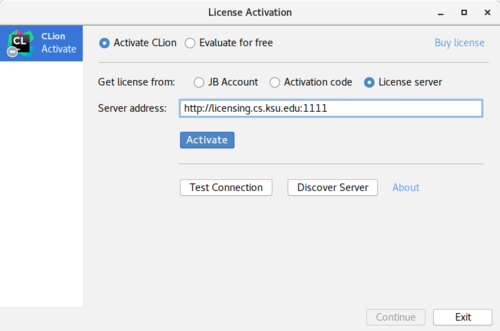
- Fill out options on the dialog as shown above. Click on the
Test Connectionbutton and you should see aConnection successfulmessage below the button. If you see this, then everything is connecting correctly. - Click on the
Activatebutton. You should now see the messageFloating ticket obtainedClick onContinueto close the dialog and finish launching the application.
The next time you use CLion, as long as you are connected to the VPN, you should get your license again. If you are not connected to the VPN, when the application tries to connect to the license server, it will fail and and ask you to reactivate. If you do not reactivate, you will get kicked out of the application.
If you ever want or need to change your license settings, click on the Help menu and select Register.
What happens when I leave? How long do I keep my account?
Please see the "Account Removal and Alumni Accounts" section of the Accounts page.
Can you guys help me with my homework?
We want to make our policy on helping students clear. The CS support staff is responsible for making sure the computing systems, networks, services, and programs on those systems function. We will help anyone who has a problem using these systems.
However, we draw the line at looking at any source code or server or program configurations students themselves have installed. This is due to the fact that CS faculty are frequently asking students to configure and manipulate software on their own as part of homework assignments. As such the CS support staff explicitly do not examine source code or other issues for students.
If you are convinced that this problem is indeed an issue related to a CS systems bug or misconfiguration, you may contact your professor and ask for assistance. At the specific request of faculty members we will look into source code or other issues, but only in order to determine the location of the problem.
As an additional clarification, this policy doesn't preclude us from answering questions and giving advice to students. The systems coordinator and students may volunteer to render help or give advice at their discretion. Please be sure your requests for advice are keeping with your professors' honor code requirements for the applicable course.
What do I do when the printer is out of paper?
If one of the printers runs out of paper, you just need to contact the system administrators. We get paper and load the printers on request.
Alternately, if no one is available at those locations you may either email support@cs.ksu.edu or talk to one of the staff members in the main CS office, Nichols 234.
How do I use VMWare in the Computing Labs
Please read our guide for full details on using a VM image for classwork.
How do I install JPF (Java PathFinder)?
Initial Steps
The JPF install script may be run from cslinux.cs.ksu.edu or any CS Linux lab machine. Windows users must ssh into cslinux using Putty or another ssh client.
Once you have completed the installation from any Linux machine, it will work on any other CS Linux machine.
- Log into cslinux.cs.ksu.edu (or any CS Linux lab machine). All following command should be run in a terminal session or terminal window.
- Make sure the Sun JDK is in your system path. You should see something like this: $ set | grep JAVA_HOME JAVA_HOME=/usr/lib/jvm/default-java $ set | grep PATH PATH=/usr/bin:/usr/local/bin:/usr/bin:/bin:/usr/games:/usr/lib/jvm/default-java
- Now you can run the install script which will place the JPF files in your home directory and build them: $ /common/public/bin/install_jpf.sh
JAVA_HOME could also be something like /usr/lib/jvm/java-6-sun. If JAVA_HOME is not set and not also in PATH, you will need to add the following to your ~/.profile:
export JAVA_HOME=/usr/lib/jvm/default-java
export PATH=$PATH:$JAVA_HOME
Logout and back in to load the new configuration, or just reload it for your current session
$ source ~/.profile
You will now have a built copy of JPF in ~/JPF2.
Running JPF
Create the following shell scripts to help you build and run JPF test classes:
compile.sh
JPF=$HOME/JPF2/ CLASSPATH=.:$JPF/jpf-core/build/jpf/ CLASSPATH=$CLASSPATH:$JPF/jpf-core/lib/* CLASSPATH=$CLASSPATH:$JPF/jpf-core/src/main/ javac -cp $CLASSPATH $1
run.sh
JPF=$HOME/JPF2/ CLASSPATH=.:$JPF/jpf-core/build/* CLASSPATH=$CLASSPATH:$JPF/jpf-core/lib/* CLASSPATH=$CLASSPATH:$JPF/jpf-core/build/classes/ CLASSPATH=$CLASSPATH:$JPF/jpf-core/bin/ CLASSPATH=$CLASSPATH:$JPF/jpf-core/src/main/ ARGS="+vm.por.sync_detection=false" ARGS=$ARGS" +jpf.report.console.property_violation=trace,error,snapshot" ARGS=$ARGS" +jpf.listener=.tools.DeadlockAnalyzer" ARGS=$ARGS" +deadlock.format=essential" java -Xmx512m -jar $JPF/jpf-core/build/RunJPF.jar +classpath=$CLASSPATH $ARGS $1
Place them somewhere in your homedir (in your JPF2 directory is probably a good place) and make them executable
$ chmod +x compile.sh $ chmod +x run.sh
See your instructor for how to use these scripts.
For More Information
Please see the Java PathFinder site:
http://javapathfinder.sourceforge.net/
How do I use PC^2 for the ACM Programming Contest?
PC^2^ is used for submitting solutions and scoring for the ACM Programming Contest. You may either use a local fat client (pc2team) or the web client (EWTeam).
Web Client: EWTeam
Point a web browser to http://pc2.cs.ksu.edu and login with the credentials provided by the contest coordinator. This should work for all browsers and all operating systems. You can also look at the current scoreboard from this app.
Local Client: pc2team
To use the local client, you must install it in at least one team member's home directory.
Previously Installed Copy
IMPORTANT NOTE: If you used PC^2 for previous contests, you must remove the old directory before installing the current one. Look for a "pc2" directory on your U: drive or in your home directory and delete it before continuing.
Installation
- Login to a Linux lab machine, or open an SSH session using PuTTY or another SSH client to cslinux.cs.ksu.edu
- Run the install script
$ /common/public/bin/install_pc2.sh
Running
In Windows
- Open a Command Prompt window (click Start->Programs->Accessories->Command Prompt, or Start->Run and type
cmd) - Change to your home files (U: drive) and enter the pc2 directory > U: > cd pc2
- Start the PC2 client U:\pc2>bin\pc2team
You cannot run pc2team by double-clicking on it in Windows Explorer, you must start it from the command prompt as described here.
In Linux
- Open a terminal window
- Enter the pc2 directory in your home directory $ cd $HOME/pc2
- Start the PC^2 client $ bin/pc2team
All Platforms
- Login using the credentials provided to you by the judges.
- Note 1: you must run the pc2team application as described here, do not
cd binfirst and then runpc2team, otherwise the client will not be able to read its configuration file and you will not be able to connect to the server.
- Note 2: if you wish to view the current scoreboard, you may run the application
pc2boardinstead ofpc2teamin the last step listed above.
Usage
Full documentation of the pc2team client can be found in the pc2 install directory in your home directory. Look in the doc directory for the file PC2V9TeamGuide.pdf.
I need some software by VMWare for a project, can you give it to me?
VMWare licensing recently changed and we no longer have an academic program available to us. The good news is that VMWare Workstation Pro and Fusion are now free to use for personal use. You can download them at the following links:
We are still investigating if it will be possible to get educational licensing for VMWare server products (ESXi, vSphere, etc).
Two Important Notes
- You will need to create an account on the Broadcom website before you can download your desired application.
- Be sure to select the product marked For Personal Use on the download page.
Can I get MATLAB?
There is no campus site-license for MATLAB. The information available from university IT can be found here: https://www.k-state.edu/it/software/software-licenses/matlab/index.html
MATLAB is not currently installed on any Computer Science lab computers. It is installed on College of Engineering lab computers.
If you wish to use it elsewhere, there are a few options for you.
I want to run MATLAB on a computer owned by the department
You may install your own copy and use one of the very small number of floating licenses available on campus. Floating licenses are shared with all computers configured to use them. They are available on a first-come-first-served basis. If you would like to do this, please contact us and we can assist you.
Alternatively, your major professor can purchase a license for you from Mathworks. Perpetual licenses are $500 each, annual licenses (must be renewed every year) are $250 each. Most additional toolboxes are $200 for perpetual or $100 for annual. Each toolbox must be purchased separately. Your major professor will need to fill out a purchase request on the Selfserv site to do this.
I want to run MATLAB on my personal computer that I own
You may purchase your own student license from Mathworks. The cost is $49 for MATLAB or $99 for the suite, which includes MATLAB, Simulink, and 10 popular toolboxes. You may also ask your major professor to pay for this license for you. Your major professor will need to fill out a purchase request on the Selfserv site to do this.
I want to run MATLAB on Beocat
Beocat has licensed the MATLAB compiler and several toolkits. You write your own code and then use Beocat to compile it to an executable. For details, see their documentation: https://support.beocat.ksu.edu/BeocatDocs/index.php/Installed_software#MatLab_compiler
Is there an open source option?
The other alternative is to use octave, which is largely compatible with Matlab, but is open source and free to use, and we have it installed on our cslinux servers. Your students can also install and use it on their Linux desktops. You can find more information about that here: https://www.gnu.org/software/octave/
Can I get a Power BI license for myself or my student?
Relevant information can be found on the KSU IT Support wiki here:
https://support.ksu.edu/TDClient/30/Portal/KB/ArticleDet?ID=235
https://support.ksu.edu/TDClient/30/Portal/KB/ArticleDet?ID=236
Request a license for yourself or a student here:
https://support.ksu.edu/TDClient/30/Portal/Requests/TicketRequests/NewForm?ID=%7eKkhxixHim8_&RequestorType=ServiceOffering
Important details:
- All students are eligible for a free student license, but a faculty or staff member must request it for them.
- Power BI Pro licenses are available for free for all faculty and most staff (I can't find documentation for which staff are eligible or not).
- Power BI Pro licenses are $23.50/year for staff that are not eligible for a free license, and $13/year for students. License cost is prorated for the calendar year and billed annually for renewal at the full rate.
- If you request a paid Pro license, please also fill out a department Purchase Requsition form so we can process payment once billed, and include Charlotte (cbruna) as the person to receive emailed invoice.
- When you request any Power BI license, free or paid, include Seth (sgsax) as the department IT support contact.
Is there any other way to get help?
The best way to get our attention is to send an email to help@cs.ksu.edu or cshelp@ksu.edu. This creates a ticket in TDX (TeamDynamix), which we use for monitoring and tracking all helpdesk issues. This in turn notifies all the sysadmin staff so we can all have a chance to respond to your question. Please do not send emails to any individual sysadmin. If you do this, there will be no record of your question, and it may take longer to be addressed.
You can also open a TDX ticket by visiting the Service Desk portal. Once you login you can navigate to the Service Catalog, and then Desktop and Mobile Computing, and finally Desktop and Mobile Device Support. From here you can Report an issue or Request service. Even if you need help with a department server, this is the fastest way to reach CS IT support staff. Using other ares of the portal will take longer for tickets to route to us. To save some time searching, you can always click here to go directly to the correct page in the portal.
If you have a question during regular business hours (Monday-Friday, 8AM-5PM), you can stop by the sysadmin offices: Engineering Hall 2217 and 2218. If your issue is quick and easy, we can usually take care of it right there for you. If it's a little more involved, we might still ask you to send us an email to open a ticket for it.
Also during business hours, you can reach us by phone at 785-532-6350 and asking for the system administrator. If there is an after-hours emergency, you can call 785-532-7790 and it will be forwarded to the system administrator.
